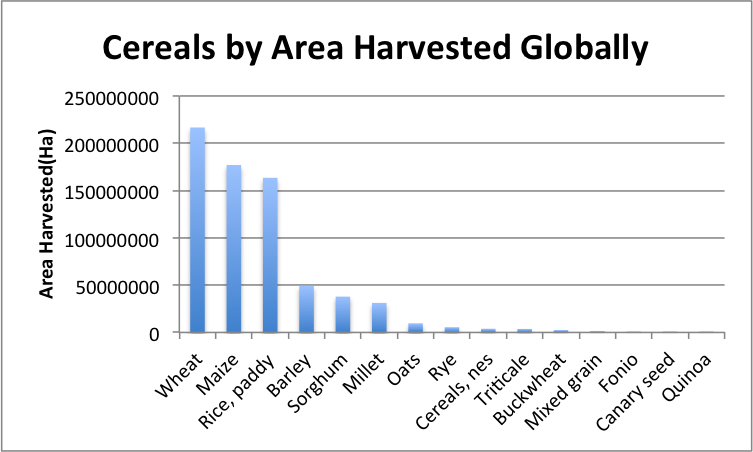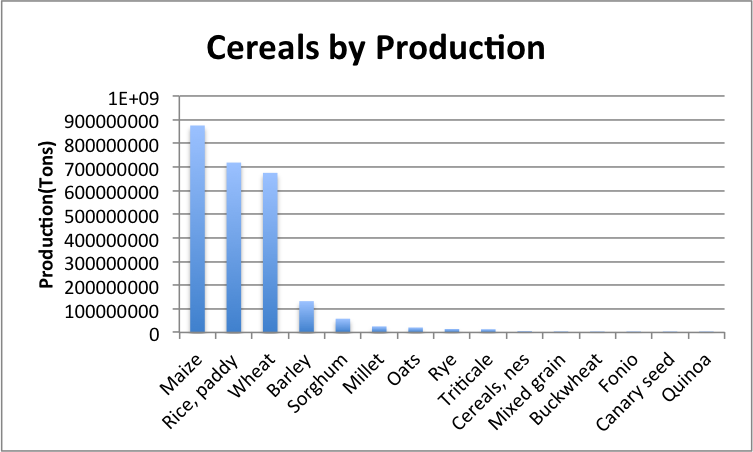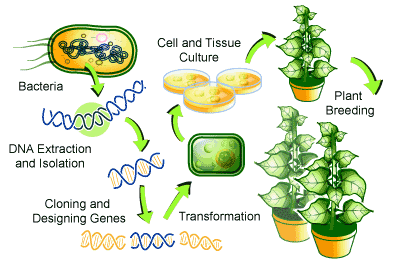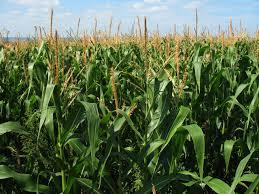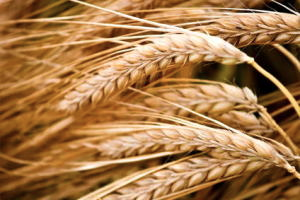Background
Food security is invariably interconnected with water security because water is needed to produce the food that feeds the billions of people on our planet. Currently, the agricultural sector uses 75 percent of global water [1]. In a world in which access to abundant, clean, freshwater is becoming more difficult, the amount of agricultural water use threatens future global water security. Our ability to produce staple crops, which comprise the majority of the agricultural sector and constitute a large part of people’s diets, will become a growing concern as water supplies dwindle. Maize (commonly known as corn), rice, and wheat are especially important because they are the most produced crops worldwide. In 2012, there were 875 million tons of corn, 718 million tons of rice, and 674 million tons of wheat grown globally [2]. Figures 1 and 2 below show the area harvested and production of all cereals globally [2]. These figures highlight the importance of these three staple crops, and why they should be the primary focus in the development of biotechnology for drought resistance and water efficiency.
Figure 1: Cereals harvested globally by area [2]
Figure 2: Cereals by production [2]
Genetic Modification
One biotechnology applied to food crops is genetic engineering. Genetic engineering is the process in which either a desired gene of an organism is isolated, spliced out of the surrounding genetic sequence, cloned using laboratory techniques, and inserted into the host organism which is being modified (see figure 3 below). The host crop then displays the desired manifestations of the gene. This means that scientists can modify a plant so that it displays traits from other plants, such as greater leaf area or a different color. Genetic engineering can also refer to the removal of a specific gene from the DNA of the target crop, which then prevents the plant from manifesting that gene. Using this technique, genetic engineers can select for certain phenotypes, and the processes related to said traits, without having to undergo selective breeding within a population. Genetic engineering takes less time than selective breeding, and in some cases is able to carry out genetic changes that would not occur naturally.
Figure 3: The process of genetic modification through isolation of a gene and insertion into the genetic sequence of a host organism [3]
Genetically modified crops have become increasingly popular in the last decade, and although they are a highly controversial topic, we view genetic modification as an emerging technology that, if carefully regulated and tested, could have beneficial effects in terms of water use. For instance, genetic modification can decrease the water requirement of the staple cereal crops mentioned above by selection for traits that increase the rate of photosynthesis and depth of root structure, as well as decrease the rate at which water is lost through transpiration. This has the potential to reduce the amount of global water resources required in food production. Due to the promising possibilities of genetic engineering, Terrascope supports research and development of potential genetic modifications that can be made to wheat, rice, and maize to increase their water efficiency and drought resistance and will work to implement genetically altered crops into the agricultural system
Figure 4: Sweet corn [4]
Maize (see figure 4), the crop with the highest global production, annually sustains losses on the order of 15 percent of potential yield attributable to drought [5]. As the climate changes as a consequence of global warming, some climates will become more arid, increasing drought and resulting in up to 10 million more lost tons of maize per year [5]. It has been estimated that 25 percent of these losses may be resolved by genetically modifying maize to be more drought tolerant [5].
A majority of the best techniques to engineer a drought-resistant breed of corn affect the crop’s ability to both attain and retain water. For instance, Monsanto, an agricultural biotechnology company, is researching transgenes of the family of cold-stress proteins, CspA and CspB, which, if copied and inserted into corn crops, can increase the plants’ abiotic stress tolerance, or rather, increase the plants’ ability to prevent water loss to the environment [5]. Other ideas being investigated include increasing sensitivity to abscisic acid, which causes the stomates to close rapidly under stressful conditions [5]; the stomates are responsible for monitoring the rate of transpiration, meaning that stomates that close quicker in dry or windy conditions will promote less water from leaving the plant and transpiring into the atmosphere. In addition, Monsanto identified a gene for drought-tolerance in the plant species Arabidopsis, and transferred the gene into corn crops and overexpressed it (meaning that they triggered the gene to produce more of the enzyme it coded for) [5]. Originally, Monsanto found, on average, this transgene caused a 15 percent yield improvement; however, Monsanto has since conceded that this level of improvement may not be as large as first observed, as improvement varies based on other environmental factors [5]. Lastly, the DREB and CBF transcription factor families are also candidate genes to alter – they may reduce the drought-induced oxidant load that leads to tissue damage, however, if over-expressed, they stunt plant growth [5]. After further research and development, such genetic improvements should be implemented into current maize species.
Figure 5: Rice [6]
Rice is a very water intensive food crop. The gene Arabidopsis HARDY has the effect of increasing the water efficiency of rice by increasing the rate of photosynthesis, and decreasing the amount of water loss through transpiration [7]. Modification of this gene has also been shown to increase the strength and amount of root structure of the plant. Plants with the HARDY gene have shown a 55% greater photosynthesis rate under normal conditions [7]. In addition, a recently discovered gene, DRO1, has been observed to increase the root depth of the plant, and thus make the plant more drought resistant [8]. Tests done with this gene spliced into the common paddy rice found that the crop performed equally well under moderate drought conditions versus drought-free conditions, and yield only fell by 30% under severe drought conditions [8]. These modifications translate into a more efficient use of water by the rice plant and increase drought resistance and salt tolerance [8], and thus should be further researched and developed for global use.
Figure 6: Wheat [9]
Genetic modifications of the wheat plant focused on particular parts of the plant, such as the root systems, and processes, such as transpiration, that can increase water use efficiency by the plant. Wheat can be genetically modified to have deeper roots by extending the vegetation period of the plant through selection for later-flowering genotypes. Deeper root systems promote more water uptake, which means the plants require less irrigation and perform better under drought conditions. An example of a current strain of drought tolerant wheat is SeriM82, also known as “stay-green wheat” which has been shown to have deeper root systems which lead to greater water uptake. One simulation has shown this increased water uptake during drought periods can lead to a 14.5 percent increase in yield [10]. Plants can also be selected for longer coleoptile growth, which is achieved through selection for certain semidwarf wheat populations. These plants tend to have faster initial growth and better crop establishment, which leads to a more efficient use of water. Another genetic modification for drought resistance currently being researched is greater transpiration efficiency. Modifications to decrease the amount of transpiration, or water loss, that occurs through the leaves of the plant include selection for greater leaf reflectance of light, smaller leaf surface, and methods to decrease the cuticular water loss. In order to increase the reflectance of leaves, selection can target for glaucousness in wheat plants (the gray blue waxy coating that some leaves have). This can also be achieved by selection for pubescence, the hairy surfaces on leaves that reflect light. These modifications should lead to less evapotranspiration through the leaves, and therefore more efficient water use [11].
Issues with Genetically Modified Crops
Mission 2017 recognizes that genetically modified crops can have repercussions for ecosystems and biodiversity and that Monsanto and other multinationals likely do not have the best interests of humankind at the core of their mission. Genetically modified crops threaten to cross-contaminate surrounding farmlands and natural habitats, leading to monoculture and low biodiversity among food crops. Because the genetically modified crops are often better adapted to the environments that they were engineered for, they outcompete naturally occurring plants. We do not want to contribute to net loss of biodiversity in wheat, maize, and rice, and for this reason supports careful analysis of land and climate to ensure that the genetically modified crop being used is well matched for each location. Cross contamination may be prevented with buffer zones between different fields, and investigation of different factors, such as wind and animal life, which could be transferring seed beyond the planted area. Even with these measures, cross contamination is very difficult to avoid because there are so many ways in which the seed can spread. Educating farmers on what genetically modified crops look like, and teaching them measures with which they can prevent their land from being contaminated by unwanted genetically modified crops can also be an important tool in lessening cross contamination.
Another issue in the realm of genetically engineered crops pertains to seed patenting. When a particular genetic formula is found for a crop, biotechnology companies like Monsanto patent and commercialize it. For instance, Monsanto’s patented strain of Bacillus thuringiensis (Bt) cotton has led to the company controlling over 95 percent of India’s cotton market [12]. This monopoly has led to a rise in prices which has left many of India’s cotton farmers in debt and unable to sustain themselves and their families through their traditional farming lifestyle.
Such patenting and commercialization, along with cross contamination, can create problems when it comes to selling seed to farmers. If a farmer has not planted a particular GM crop, but through cross contamination has the crop growing on their fields, they can be subject to a lawsuit at the hands of the people who have a patent on said GM crop. This could be prevented through laws stating that a farmer can only be sued for this kind of behavior if there is physical evidence of direct, intentional theft of the patented crop. Also, education for farmers to help them identify unwanted GM crops on their land, and effectively eliminate them, would be helpful in preventing cross contamination. Also, the company that owns the patent makes it illegal for the farmer to save the seed from the previous year, making it easy for farmers to go into debt because they constantly need to find the money to afford new seed, and thus need to keep increasing their yield. In India, for instance, farmers find themselves needing to take out loans each year in order to be able to afford the seed. This leads to farmers finding themselves constantly in debt, and in many parts of the world, an increased rate of farmer bankruptcies. Protection laws could allow farmers to legally keep the seed of the previous year without being at risk of a lawsuit by the company owning the patent. The issue of seed patenting and commercialization also poses significant problems in developing areas, where GM seeds, through competition and contamination, are slowly destroying the diversity of seed that once existed. If an entire agricultural sector is based on one type of crop with one specific genetic makeup, when the crop fails or does not have profitable yields on any given years, it puts the livelihoods of poorer farmers in danger.
The issues with genetically engineered crops outlined above are heavily linked to the political and economic structure in which genetically modified crops are created, produced, and distributed. As of now, it is true that genetically modified crops are not beneficial to small farms, and pressure from biotech companies and agribusinesses is forcing small farms to disappear. Not only are small farms more productive in producing food than large farms, but also they are better at introducing sustainable practices than large industrial farms. For this reason, Mission 2017 will support a downscaling of the biotech and agricultural sector, in order to encourage the production and distribution of a variety GM crops that align with the specific needs of farmers in different areas. In order to have a healthy agriculture sector that incorporates GM crops, there needs to be careful governmental regulation of biotechnology companies. Such regulations should prevent such companies from creating monopolies and abusing farmers not at fault for the cross contamination of patented crops. Another important factor in need of change is legislation that encourages industrial farming. For instance, during the New Deal, a set of economic programs established in the United States in the 1930s, there was a price floor that guaranteed a fair price for corn, instead of allowing the price to be determined by the free market. This meant that farmers did not have to constantly continue increasing their yields in order to prevent going bankrupt, as they do now. A system that ensures a fair price for crops encourages small farmers and greater biodiversity. These kind of political and economic policies would be beneficial to the introduction of GM crops as it would encourage smaller farms and greater crop diversity, and prevent the large industrialization of the farming process which leads to thousands of acres of land all planted with a single strain of genetically modified plant. Such policies could be implemented in many countries, and would be especially beneficial in developing countries to prevent the industrial farming process from gaining the momentum that it has gathered in the United States.
Solution
Mission 2017 does not support the current genetic modified crop and large agricultural business culture, where one general genetically modified crop, such as Monsanto’s Roundup Ready corn, is developed and distributed to thousands of farmers to grow on their land, as we recognize the problems that this system creates on all levels, from environmental to societal. Instead, we aim to change the culture in which genetically modified crops are created and used in agriculture. Changing the genetically modified crop culture is the first essential step to the creating of water efficient and drought resistant genetically modified crops which are truly used in a sustainable manner. A major difficulty will be to get the multinational companies for whom increased profit is their main goal to work with governments and academic researchers to ensure that the future of food production benefits humankind and that we are not tied low diversity genetically modified crops.
On the biological engineering level, there are very promising possibilities in genetic modification to decrease the water needs of maize, rice, and wheat. Most of these technologies are still in the process of development and testing. Some of these crops, in particular the genetically modified drought resistant corn, are very close to being released on the market. Mission 2017 supports agricultural biotechnology in the form of crops genetically modified for drought resistance and water efficiency, with the condition that all of these crops have been carefully researched and tested before their release on the market. In China, extensive research is being conducted into ways to sustainable increase crop yields through biotechnology and better farming practices. Scientists, independent of large biotech companies, are analyzing each farm as a system in order to completely understand the ways in which crop yield can be increased while preventing further environmental degradation. Mission 2017 supports this kind of research into biotechnology and its close connection with the area where it is being implemented [13].
Furthermore, Mission 2017 supports careful governmental regulation of biotechnology companies through antitrust laws which prevent crop monopolies, legislation to protect farmers who unintentionally acquire patented crops through cross contamination, as well as government instituted price floors similar to those which existed in the US during the 1930s. Such price floors, or “minimum wages” for certain crops should be put in place for maize, wheat, and rice, and then extended to other crops over time and would encourage small farmers by ensuring stability in crop prices. The money for these price floors could come from the large subsidies some farmers receive, as well as taxes on larger multinational biotech and agricultural companies. By instituting these price floors, farmers will have not be subject to volatile market fluctuations Lastly, Mission 2017 endorses legislation that promotes small scale farming as opposed to large industrial farms.
Mission 2017 will start by encouraging competition in the biotech sector by lobbying the United Nations for a series of regulations and guidelines for countries developing widespread genetic modification, especially in common food crops. These guidelines would include regulatory laws to stop large multinational biotech companies from gaining too much power and creating monopolies. Then, with funding from participatory countries, Mission 2017 will create an international organization to keep a library of seeds of non-GMO food crops, and conduct biotechnology research. This would create a public organization developing GMOs which would be independent of the influences of large biotech companies, and ensure that the biodiversity of the planet in way of food crops be safeguarded even when genetically modified crops are being used instead of traditional varieties. This combination of a public research front into genetic engineering of food crops, as well as regulatory laws to prevent large biotech companies from eliminating competition, will ensure the creation of genetically modified crops that are more thoroughly researched and specific to the target lands and climates, and designed to have positive effects on communities.
Further support will be applied in developing countries that are looking to increase food security and water efficiency in agriculture through genetically modified crops. Mission 2017’s support and push for implementation of water-efficient crops in developing countries is crucial, for many of these nations are rapidly growing in population, and it is important to establish larger scale agricultural systems which incorporate sustainable use of water and fair farming practices from the start. In establishing incentive programs and regulatory laws in developing countries, the people from these countries need to be involved in the process from the beginning. This is the only way to ensure that policies and programs are created which will truly fit the needs of the target communities. Genetically modified crops that are drought-tolerant or water-efficient are a global technological solution that must be researched, developed and applied to help reduce water use in the agricultural sector.
Mission 2017 recommends the following potential solutions:
- United Nations: creation of a set of international regulations and guidelines for the introduction of genetically modified crop production
- Protection Laws for Farmers against unfair lawsuits from biotechnology companies accusing them of stealing seed that has contaminated their farms via natural vectors, as well as laws to allow them to keep the seed from the previous year
- Antitrust and regulatory laws for biotech and agribusinesses to prevent them from creating monopolies and regulate the purchasing of smaller farms
- Fix price floors for food crops to give small farmers more independence, and keep them from becoming subject to the volatility of food markets. Funding to support these price floors can come be derived from the taxes on large agribusinesses and biotech companies, as well as the subsidies that larger farmers currently get
- Set up an international public library of seed and biotechnology research organization to keep track of the biodiversity of different food crops as well as conduct biotechnology research for the public good
- Incentivize research into water efficient and drought resistant genetic modifications that are designed around the target region’s land and climate conditions
Through encouraging competition between smaller scale biotech companies, small-scale farming, and an international public research organization and library of biodiversity, Mission 2017 aims to create a genetically modified crop culture that is healthier and more comprehensive than the one we currently have. Genetically modified crops could be created with the specific needs of each farmer in mind, and through small farming practices, be rotated with different strains of the same crop, or with different crops altogether. It would be in this kind of agricultural sector that water efficient and drought resistant genetically modified crops could, along with other water efficient farming practices, have a huge impact on the total water used in ensuring food security. While many of these changes may seem radical, a future for the planet that includes water and food security for a steadily growing population requires a new approach.
References
1. Wallace, J.S. 2000. Increasing agricultural water useefficiency to meet future food production. Agriculture, Ecosystems & Environment, Volume 82, Issues 1–3, December 2000, Pages 105-119, ISSN 0167-8809, http://dx.doi.org/10.1016/S0167-8809(00)00220-6.
2. FAOSTAT. (2013). Global Cereal Production [Data file]. Retrieved from http://faostat3.fao.org/faostat-gateway/go/to/download/Q/QC/E
3. Genetic Engineering [Diagram of Gene Modification] (2013). Retrieved November 25th, 2013, from http://oregonstate.edu/orb/terms/genetic-engineering
4. Retrieved November 25th, 2013, from http://www.melonacres.com/SweetCorn.html
5. Edmeades, Greg O. 2008. Drought Tolerance in Maize: An Emerging Reality. A Feature In James, Clive. 2008. Global Status of Commercialized Biotech/GM Crops: 2008. ISAAA Brief No. 39. ISAAA: Ithaca, NY.http://www.salmone.org/wp-content/uploads/2009/02/droughtmaize.pdf
6. Rice Plant [Image of rice plant] (2013). Retrieved November 25th, 2013, from: http://www.wired.com/wiredscience/2013/09/the-fda-adds-a-postscript-on-arsenic-and-rice/
7. Karaba, A., Dixit, S., Greco, R., Aharoni, A., Trijatmiko, K. R., Marsch-Martinez, N., Pereira, A. (2007). Improvement of water use efficiency in rice by expression of HARDY, an Arabidopsis drought and salt tolerance gene. Proceedings of the National Academy of Sciences, Retrieved from http://www.pnas.org/content/104/39/15270.short
8. Uga, Y., Sugimoto, K., Ogawa, S., Rane, J., Ishitani, M., Hara, N., … Yano, M. (2013). Control of root system architecture by deeper rooting 1 increases rice yield under drought conditions. Nature Genetics, 45(9), 1097–1102. doi:10.1038/ng.2725
9. Wheat. (2012). Retrieved November 25th, 2013, from http://www.sciencedaily.com/releases/2012/11/121128142144.htm
10. Manschadi AM, Christopher J, deVoil P, Hammer GL (2006) The role of root architectural traits in adaptation of wheat to water-limited environments. Functional Plant Biology 33, 823–837.
11. Richards, R. A., Rebetzke, G. J., Condon, A. G., & van Herwaarden, A. F. (2002). Breeding opportunities for increasing the efficiency of water use and crop yield in temperate cereals. Crop Science, 42(1), 111-121. http://search.proquest.com.libproxy.mit.edu/docview/212591052?accountid=12492
12. Jacobsen, S.-E., Sørensen, M., Pedersen, S. M., & Weiner, J. (2013). Feeding the world: genetically modified crops versus agricultural biodiversity. Agronomy for Sustainable Development, 33(4), 651–662. doi:10.1007/s13593-013-0138-9
13. Zhang, F., Chen, X., & Vitousek, P. (2013). Chinese agriculture: An experiment for the world. Nature, 497(7447), 33–35. doi:10.1038/497033a
